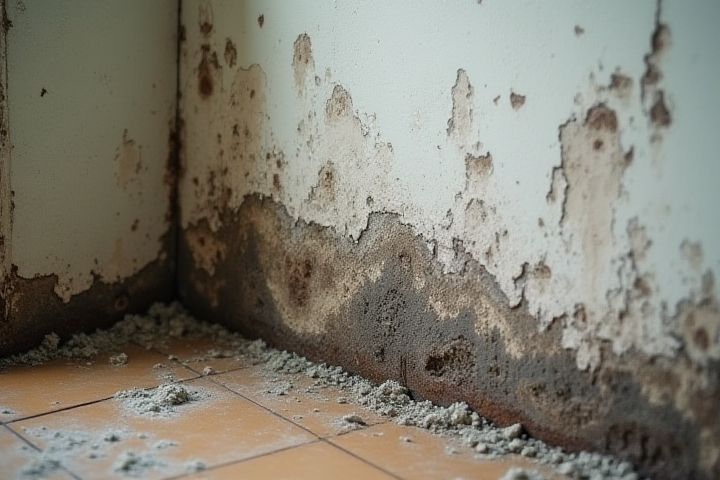
Mold growth in houses is primarily caused by excessive moisture, often resulting from high humidity levels, leaks, or inadequate ventilation. Common sources of moisture include water pipes that may leak, condensation on cold surfaces, or water damage after heavy rains. Mold thrives in damp, warm environments, typically found in areas like basements, bathrooms, and under sinks. Poor air circulation can trap humidity, creating the ideal breeding ground for mold spores. To prevent mold, it is essential to control moisture levels, ensure proper ventilation, and promptly address any water issues in your home.
Why Does A House Get Moldy
High humidity levels
High humidity levels, typically above 60%, create an ideal environment for mold growth in your home. When moisture accumulates in areas like basements, bathrooms, or kitchens, it can lead to condensation on surfaces, fostering mold spores to thrive. Mold can develop within 24 to 48 hours in these humid conditions, which poses health risks such as respiratory issues and allergies. Regularly monitoring and controlling indoor humidity with dehumidifiers or proper ventilation can significantly reduce the likelihood of mold infestations.
Poor ventilation
Poor ventilation significantly contributes to mold growth in houses by trapping excess moisture in the air. When rooms lack adequate airflow, humidity levels can rise above the optimal range of 30-50%, creating a perfect environment for mold spores to thrive. Areas such as basements, bathrooms, and kitchens are particularly vulnerable, as they often experience higher humidity due to activities like cooking or showering. To combat mold, it's essential to ensure that your home has sufficient air circulation, using exhaust fans and opening windows when possible.
Water leaks
Water leaks are a primary cause of mold growth in homes, as moisture creates an ideal environment for mold spores to thrive. Common sources of these leaks include aging roofs, faulty plumbing, and poor drainage systems, which can introduce excess humidity into your living space. Within 24 to 48 hours of a water leak, mold can begin to develop, making prompt repairs crucial to prevent extensive damage. Maintaining humidity levels below 60% and addressing leaks immediately can significantly reduce the risk of mold infestations in your home.
Condensation issues
Condensation issues often lead to mold growth in houses due to excess moisture accumulation on surfaces like walls, ceilings, and windows. When warm, humid air comes into contact with cool surfaces, it cools down and condenses into water droplets, creating an environment conducive to mold spores. Inadequate ventilation exacerbates this problem, allowing humidity levels to rise and promoting mold proliferation. To prevent mold, ensure proper insulation and adequate airflow, especially in high-moisture areas such as kitchens and bathrooms.
Inadequate insulation
Inadequate insulation can lead to significant moisture accumulation within a house, which creates an ideal environment for mold growth. When insulation does not effectively regulate temperature or humidity levels, warm air can condense on cold surfaces, fostering a damp atmosphere. Studies indicate that nearly 50% of homes may experience mold issues due to poor insulation, especially in attics and crawl spaces. To protect your home and health, investing in high-quality insulation can significantly reduce moisture and, consequently, lower the risk of mold development.
Flooding history
Flooding significantly increases the risk of mold growth in homes, as it introduces excessive moisture into the environment. When water levels rise, it can saturate walls, floors, and furnishings, creating an ideal breeding ground for mold spores, which thrive in damp conditions. In areas with a history of flooding, such as regions prone to heavy rainfall or storm surges, properties may remain vulnerable even after the water recedes, due to prolonged moisture retention in hidden spaces. Taking preventative measures, like improving drainage and using mold-resistant materials, can help safeguard your home against mold proliferation following flooding events.
Damp basement
A damp basement becomes a breeding ground for mold due to high humidity levels and inadequate ventilation. Moisture can seep through walls and the foundation, creating ideal conditions for mold spores to thrive. If water leaks from pipes or heavy rainfall seeps in, it exacerbates the problem, allowing mold to grow on organic materials like wood and drywall. Regularly monitoring humidity levels and implementing proper drainage solutions are essential to prevent mold growth in your basement.
Roof damage
Roof damage is a primary factor in mold growth within a house, as compromised roofing materials can lead to leaks and excess moisture accumulation. A 1% moisture increase in your home can significantly elevate the risk of mold development, especially in areas that are poorly ventilated. Water intrusion from damaged shingles, flashing, or gutters creates an environment where mold spores can thrive, causing structural damage and health risks. Regular inspections and maintenance of your roof can effectively prevent mold by ensuring that any potential weaknesses are promptly addressed.
Plumbing problems
Plumbing problems, such as leaking pipes or poorly sealed joints, are primary contributors to mold growth within a house. When water leaks from damaged plumbing systems, it creates damp environments that facilitate mold spores' development. Areas like basements, under sinks, and behind walls often become mold hotspots due to inadequate ventilation and moisture retention. To protect your home from potential health hazards, it's essential to promptly address plumbing issues and ensure proper water drainage and ventilation throughout your living space.
Organic materials in walls
Mold thrives on organic materials such as wood, paper, and natural fibers found in walls and insulation. When humidity levels exceed 60%, these organic substances provide the ideal environment for mold spores to grow, often within 48 hours of moisture exposure. This can occur due to leaks, condensation, or inadequate ventilation. Regular inspection and maintenance of your home can help prevent mold growth, safeguarding both your health and property.
